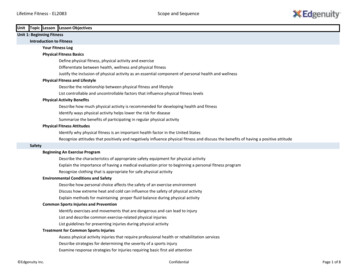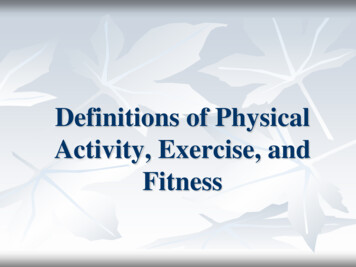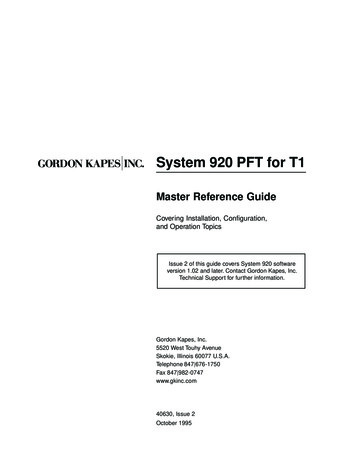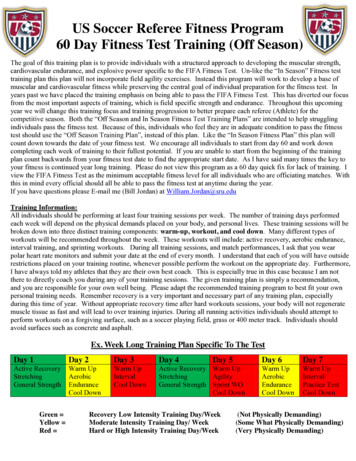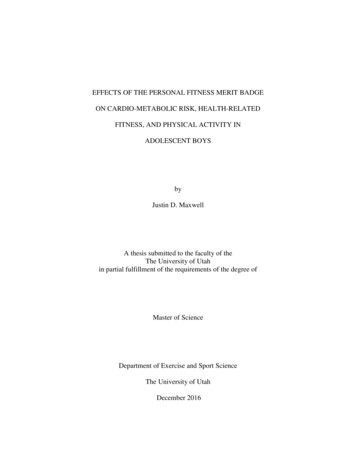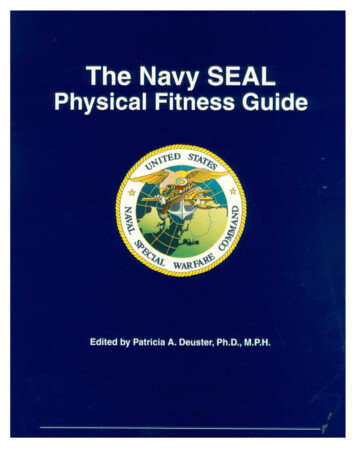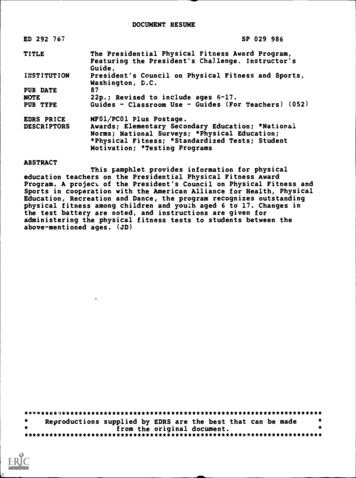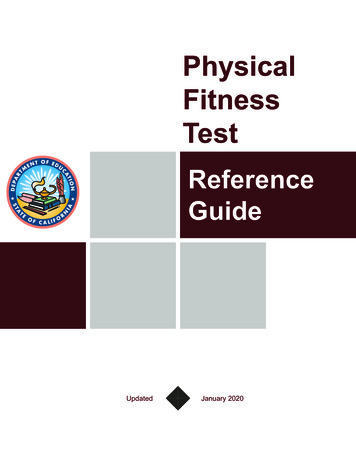
Transcription
PhysicalFitnessTestReferenceGuideUpdatedJanuary 2020
California Physical Fitness Test (PFT) Reference GuideTable of ContentsSection 11Introduction and Overview1FITNESSGRAM Performance StandardsAdministration Information234Testing Students with Disabilities5Section 2 Fitness Areas and Tests6Aerobic Capacity7One-Mile Run20-Meter (20m) PACERPACER Goal Setting TableFemalesMalesWalk TestBody Composition9101111121213Skinfold MeasurementsBioelectric Impedance AnalyzerBody Mass IndexMuscle Strength, Endurance, and Flexibility15161718Abdominal Strength and Endurance18Curl-UpTrunk Extensor Strength and Flexibility1920Trunk LiftUpper Body Strength and Endurance2122Push-UpModified Pull-UpFlexed-Arm HangFlexibility23242526Back-Saver Sit and ReachShoulder StretchJanuary 20202728iiCalifornia Department of Education
Section 1Introduction and Overview
California Physical Fitness Test (PFT) Reference GuideThis reference guide is designed to assist local educational agency (LEA)1 staff in becoming familiarwith the California Physical Fitness Test (PFT). The PFT is a comprehensive, health-related batteryof physical fitness tests for students in California.This guide includes a detailed description of each fitness area tested and suggestions for facilitatingthe administration of each test. Following each description are tables that display the data collectionrequirements, the performance standards by age and gender, and, if available, the formulas used togenerate the scores.Please note that this guide is not designed as a replacement for the FITNESSGRAM /ACTIVITYGRAM Test Administration Manual.2 This can be found on the Cooper Institute's websiteat es/662.pdf.California Education Code (EC) Section 60800 requires all LEAs to administer the PFT annually,February 1 through May 31, to public school students in grades five, seven, and nine. LEAs mayrequest a California State Board of Education (SBE) waiver to administer the PFT outside thedesignated testing window. Students are required to take the PFT whether or not they are enrolledin a physical education class or participate in a block schedule.FITNESSGRAM The SBE designated the FITNESSGRAM as the PFT for students in California public schools. TheFITNESSGRAM is designed to assess the three main categories of fitness: (1) aerobic capacity;(2) muscular skeletal fitness; and (3) body composition. It is composed of the following six keyfitness areas: Aerobic Capacity Body Composition Abdominal Strength and Endurance Trunk Extensor Strength and Flexibility Upper Body Strength and Endurance FlexibilityA level of fitness in these six areas offers a degree of defense against diseases that are associatedwith inactivity. The test results can be used by students, teachers, and parents/guardians to monitoroverall fitness and evaluate their LEA's physical education program.¹ Throughout this manual, LEAs include school districts, county offices of education, and charterschools that are independent for assessment purposes (i.e., independent charter schools).² Throughout this manual, the FITNESSGRAM /ACTIVITYGRAM Test Administration Manual(Revised Updated Fourth Edition) is referred to as the FITNESSGRAM Test AdministrationManual.January 20202California Department of Education
California Physical Fitness Test (PFT) Reference GuidePerformance StandardsThe FITNESSGRAM uses health-related standards to evaluate performance. The desiredperformance standard for each fitness-area test is the Healthy Fitness Zone (HFZ). This standardrepresents the level of fitness associated with good health. Students should strive to achieve ascore within the HFZ for each fitness-area test.Commencing with the 2018–19 PFT administration, the PFT recognizes a third gender choice ofnonbinary. While the California Department of Education (CDE) continues to encourage The CooperInstitute to develop standards for our nonbinary students, the PFT performance standards of theFITNESSGRAM are based on female and male biological sexes; therefore, the “Status” fields onthe student scored reports for the students who identify as nonbinary will be blank. LEAs may assiststudents in assessing their PFT performance by comparing their scores to current Healthy FitnessZone charts available at .Although the FITNESSGRAM Scientific Advisory Board’s position statement titled “GenderUses in FITNESSGRAM ,” maintains that the use of a child’s sex at birth is still the preferredmethod to obtain the most accurate FITNESSGRAM results, California law provides transgenderstudents equal access to activities and facilities on the basis of their gender identity. The CDErecommends administering the PFT in accordance with the student's identified gender and use theperformance standards associated with the identified gender. The following is an excerpt from theaforementioned position statement:Emphasis on assessments should be placed on self-monitoring and trackingimprovement over time. However, if standards are to be applied to transgender,gender-neutral (non-binary), or students identifying differently than their sex at birth,FITNESSGRAM results would be most accurate using the child’s sex at birth. This isbecause of the differential effects and timing of maturation and not due to other socialand cultural differences between males and females.That being said, it is also up to the parents, students, and teachers to determine whatis in the best interest of a student’s wellbeing. If using the sex at birth would causeundue emotional stress upon the student, then it is up to the teacher and/or parent/guardian to determine which gender identity is the most appropriate. Teachers shouldmaintain complete confidentiality and sensitivity when implementing and recordingresults for all students regardless of gender identity.In addition, the CDE recommends that LEAs reference local policies or legal counsel at the locallevel as it relates to the performance standards.As part of PFT administration, LEAs are required to collect student-level demographic data andsubmit that data to the state.The CDE PFT Office does not change any student-level data receivedfrom LEAs nor must PFT data match student enrollment data.January 20203California Department of Education
California Physical Fitness Test (PFT) Reference GuideThe FITNESSGRAM performance standards are updated on a regular basis. The current-yearstandards should always be used and are included in tables throughout this reference guide. Theyare posted in stand-alone versions on the CDE PFT FITNESSGRAM : Healthy Fitness Zone Chartsweb page at Each student’s performance is classified by the HFZ or other zones, depending on the fitness area,as follows:Aerobic capacity Healthy Fitness Zone Needs Improvement Needs Improvement—Health RiskBody composition Very Lean Healthy Fitness Zone Needs Improvement Needs Improvement—Health RiskMuscle strength, endurance, and flexibility Healthy Fitness Zone Needs ImprovementThe "Needs Improvement," or "NI," designation signifies a fitness area in which a student’s score isnot in the HFZ. The student would benefit from physical activities designed to improve performancein the designated fitness area to achieve the HFZ. "NI—Health Risk" specifically indicates increasedhealth risks because of the student’s level of fitness.It is possible that some students’ scores will exceed the HFZ. For Body Composition, this isdesignated as the Very Lean Zone. It is important that students and their parents or guardians beaware if Body Composition scores place them in the Very Lean Zone.Administration InformationMost of the FITNESSGRAM tests can be administered in a space equivalent to the size of mostclassrooms. The test options for Aerobic Capacity require the greatest amount of space. One ofthese options, the Progressive Aerobic Cardiovasculor Endurance Run (PACER), requires a spacethat can accommodate the 15-meter (15m) or 20-meter (20m) distance needed to carry out the test.Schools with limited space may consider using one of the following options: Classroom, lunchroom, auditorium, or other similar space Physical education facility on another school campus Local park and recreation facilityJanuary 20204California Department of Education
California Physical Fitness Test (PFT) Reference GuideLEAs should review their confidentiality practices to make sure that appropriate protocols are inplace to ensure as much privacy as possible when administering the PFT (e.g., screens to avoidobservation of measurements—especially body composition measurements) and to safeguard PFTresults from students other than the one being tested. In addition, LEAs should develop a receptiveprocess to ensure the safety and concerns of their students and students’ parents or guardians bybeing sensitive to such variables as preexisting special needs, body composition, and maturationstage of the students.Testing Students with DisabilitiesCertain variations or accommodations may be provided for students with disabilities who needspecial assistance on the PFT. Variations and accommodations should be specified in the student’sindividualized education program (IEP) or Section 504 plan. "Matrix 2: Matrix of Variations,Accommodations, and Modifications for Administration of the PFT" provides a list of the types ofvariations and accommodations that are available for the PFT. This matrix is posted on the CDEAssessment Information web page at http://www.cde.ca.gov/ta/tg/ai/, under the “Testing Matrices"section.Most of the fitness areas of the FITNESSGRAM provide two or three test options, so most students,including those with disabilities, have the opportunity to participate in the PFT. All students withdisabilities who are unable to take the entire PFT should be given as much of the test as eachstudent’s physical condition permits.The IEP or Section 504 plan team is responsible for deciding how students with disabilities willparticipate in the PFT. PFT data should be included for every student, even if they do not take thephysical portion of the test. Demographic data should be submitted and the data field(s) for thefitness areas(s) the student did not participate in should be left blank.January 20205California Department of Education
Section 2Fitness Areas and Tests
California Physical Fitness Test (PFT) Reference GuideAerobic CapacityThree test options are provided under the Aerobic Capacity test area: One-Mile Run 20-Meter Progressive Aerobic Cardiovascular Endurance Run (20m PACER) Walk TestAll test options under the Aerobic Capacity test area are reported in terms of VO2Max, which isa measure of maximum oxygen consumption during exercise. Tables 1 and 2, on the followingpage, present informatoin about the HFZs for Aerobic Capcity. Additional information about AerobicCapacity and VO2Max can be found in the video provided by The Cooper Institute athttps://www.youtube.com/watch?v eiS8xGzRlwI.Physical education teachers can calculate VO2Max for any of the Aerobic Capacity test options byusing the calculator provided in an Excel spreadsheet that is available on the CDE PFT web page athttp://www.cde.ca.gov/ta/tg/pf/.The FITNESSGRAM and HFZs are registered trademarks of The Cooper Institute.VO2Max refers to the maximum oxygen consumption for an individulal during exercise. The acronymis derived from V volume per time, O oxygen, and max maximum.ParticipationStudents who score an "insufficient" in Aerobic Capacity are considered as having participated inAerobic Capacity when the scoring program calculates a student’s participation level.Administration Tips for the Aerobic Capacity Tests Practice pacing and techniques for heart rate monitoring. Allow students adequate time to warm up and cool down. To avoid potential health and safety issues, do not administer a test inunusually high temperatures or humidity or when the wind is strong.January 20207California Department of Education
California Physical Fitness Test (PFT) Reference GuideTable 1. HFZs for Aerobic Capacity for Females*Age101112131415161717 NI–HealthRisk 37.3 37.3 37.0 36.6 36.3 36.0 35.8 35.7 35.3NIHFZ37.4 – 40.137.4 – 40.137.1 – 40.036.7 – 39.636.4 – 39.336.1 – 39.035.9 – 38.835.8 – 38.735.4 – 38.5 40.2 40.2 40.1 39.7 39.4 39.1 38.9 38.8 38.6*As there are no nonbinary standards, nonbinary students may compare their scores to this chart toassess their performance.VO2Max standards are not available for students ages five through nine.Table 2. HFZs for Aerobic Capacity for Males *Age101112131415161717 NI–HealthRisk 37.3 37.3 37.6 38.6 39.6 40.6 41.0 41.2 41.2NIHFZ37.4 – 40.137.4 – 40.137.7 – 40.238.7 – 41.039.7 – 42.440.7 – 43.541.1 – 44.041.3 – 44.141.3 – 44.2 40.2 40.2 40.3 41.1 42.5 43.6 44.1 44.2 44.3* As there are no nonbinary standards, nonbinary students may compare their scores to this chart toassess their performance.VO2Max standards are not available for students ages five through nine.January 20208California Department of Education
California Physical Fitness Test (PFT) Reference GuideOne-Mile RunThe One-Mile Run estimates aerobiccapacity from running performance.Students are instructed to run a mile asfast as they are able. Walking is permittedfor students who cannot run the totaldistance. The time taken to complete therun is recorded in minutes and seconds.Table 3, below, presents the data collectionrequirements for the One-Mile Run.Table 3. One-Mile Run: Data Collection Requiremnts:DataGenderAgeAge requires thestudent’s date of birthMale (M),and PFT start date.femaleAcceptableAge will be calculated(F),valuesautomatically bynonbinarythe system as the(N)student’s age on thefirst day of testing.Height HeightWeight(feet) (inches) (pounds)3–70–1130–400TimeTime(minutes) (seconds)3–590–59Additional scoring rules for the One-Mile Run: A time of 59 minutes and 59 seconds should be used to indicate students who attemptedthe test but did not complete it. Students with 59 minutes and 59 seconds will be scored"insufficient" (I) and reported as "Needs Improvement." The time for grade five students who are younger than age nine will not be scored but willbe reported in the HFZ regardless of their One-Mile Run time or number of laps completed.The time for grade five students who are age nine will be scored and reported using thestandards for students who are age ten.One-Mile Run equation:VO2Max (.21 * age * gender) – (.84 * BMI) – (8.41 * time) (.34 * time * time) 108.941 Gender 1 for males and 0 for females2 Time is in minutes. One-Mile Run time One-Mile Run minutes (One-Mile Runseconds/60) [this will convert One-Mile Run time to a decimal]; example: 4 minutes and 30seconds converts to 4 (30/60) 4.5Cureton, K. J.; M. A. Sloniger ; J. P. O’Bannon; Black, D. M.; and W. P. McCormack 1995. "AGeneralized Equation for the Prediction of VO2 Peak from One-Mile Run/Walk Performance."Medicine and Science in Sports and Exercise 27: 445–51.2As there are no standards for students who identify as nonbinary, nonbinary students mayconsult these formulas to calculate their scores.9January 2020California Department of Education¹
California Physical Fitness Test (PFT) Reference Guide Body mass index (BMI) Weight / (Height * Height) Height .3048 * (feet) .0254 * (inches) [this will convert height from feet and inchesto meters] Weight 0.45359237 * (pounds) [this will convert weight from pounds to kilograms]20-Meter (20m) PACERThe 20m PACER estimates aerobiccapacity from the number of laps (20meters in distance) that are completed.Unlike the other two Aerobic Capacityoptions, the PACER starts out easy andbecomes progressively more difficult.For this test, a pair of parallel lines aredrawn 20 meters apart. Students starton one line, run the distance, and touchthe opposite line with one foot. Once they hear the sound of a single beep, students turn aroundand run back to the starting line. Every minute, as indicated by a triple beep, the pace gets faster.Students continue in this manner until they fail twice to touch the line before they hear the beep.Table 4 below presents the data collection requirements for the 20-Meter Pacer.Table 4. 20-Meter Pacer: Data Collection Requirements:DataAcceptablevaluesGenderAgeLapsM, F, NAge requires the student’s date of birth and PFT start date.Age will be calculated automatically by the system as thestudent’s age on the first day of testing.1–190Additional scoring rules for the PACER: In the proper administration of the PACER, a student is allowed two form breaks with thefirst form break counting as a lap. A student who commits two form breaks after the start ofthe PACER should be scored as completing one lap. If the 15-meter (15m) PACER is administered, the 15m PACER laps first need tobe converted to 20-meter laps. The PACER Conversion Chart is located in theFITNESSGRAM Test Administration Manual. The time for grade five students who are younger than age nine will not be scored, but willbe reported in the HFZ regardless of the One-Mile Run time or number of laps completed. The time for grade five students who are age nine will be scored and reported using thestandards for students age ten.January 202010California Department of Education
California Physical Fitness Test (PFT) Reference GuidePACER equation:The formula for scoring the PACER using laps, age, and gender is proprietary to HumanKinetics and The Cooper Institute; therefore, it is not published in this guide.To assist with local scoring, the CDE has included the PACER calculation in an Excel spreadsheet,available on the CDE PFT web page at http://www.cde.ca.gov/ta/tg/pf/pftresources.asp. Foradditional information including the gender, age, and number of laps needed to meet the PACERHFZ, see the “PACER Goal Setting Table” below.PACER Goal Setting TableThe PACER is one of the three Aerobic Capacity test optoins available in the FITNESSGRAM .The PACER is reported in terms of VO2Max; however, beginning in 2013–14, HFZs are basedon student gender, age, and laps only. This table provides the minimum number of 20m laps thatstudents need to achieve the HFZ for the PACER, and the corresponding VO2Max. Althoughstudents can set goals based on the minimum number of PACER laps, teachers are encouraged todiscuss the importance of aerobic capacity and to ensure that students understand how VO2Maxis influenced by gender and age. As there are no nonbinary standards, nonbinary students maycompare their scores to these charts to assess their performance. Table 5 and 6, below and on thefollowing page, present the HFZs for the 20m PACER.FEMALESTable 5. 20m PACER Healthy Fitness Zones for females*AgeMinimum Number of 20mPACER LapsAerobic Capacity HFZVO2max1017 40.21120 40.21223 40.11325 39.71427 39.41530 39.11632 38.91735 38.817 38 38.6* As there are no nonbinary standards, nonbinary students may compare their scores to this chart toassess their performance.January 202011California Department of Education
California Physical Fitness Test (PFT) Reference GuideMALESTable 6. 20m PACER Healthy Fitness Zones for males*AgeMinimum Number of 20mPACER LapsAerobic Capacity HFZVO2max1017 40.21120 40.21223 40.31329 41.11436 42.51542 43.61647 44.11750 44.217 54 44.3* As there are no nonbinary standards, nonbinary students may compare their scores to this chart toassess their performance.Walk TestThe Walk Test estimates aerobic capacityfrom heart rate response to a one-mile walk.Students are instructed to walk one mile asfast as possible. Immediately after the walk,the heart rate is determined. This heart rate(heart beats per minute) is used along withthe total walk time (minutes and seconds)and the weight of the student to estimateaerobic capacity. Table 7, below, present thedata collection requirements for the WalkTest.Table 7. Walk Test: Data Collection RequirementsDataAcceptablevaluesJanuary 2020GenderAgeHeart Rate(# of beathsper minute)Weight(pounds)M, F, NAge requires thestudent’s date of birthand PFT start date.Age will be calculatedautomatically bythe system as thestudent’s age on thefirst day of testing.30–25030–40012TimeTime(minutes) (seconds)3–590–59California Department of Education
California Physical Fitness Test (PFT) Reference GuideAdditional scoring rules for the Walk Test: A time of 59 minutes and 59 seconds should be used to indicate students who attemptedthe test but did not complete it. Students with 59 minutes and 59 seconds will be scoredinsufficient (I) and reported as Needs Improvement. The Walk Test is allowed only for students who are ages thirteen and older. If theWalk Test is given to students younger than age thirteen, it cannot be scored and will notbe reported, as Walk Test HFZs have not been established for students younger than agethirteen.Walk Test equation:VO2Max 132.853 (6.315 * gender) – (.0769 * weight) – (.3877 * age) –(3.2649 * time) – (.1565 * heart rate)1 Gender 1 for males and 0 for females2 Time is in minutes. Walk Test time Walk Test minutes (Walk Test seconds/60) [this willconvert One-Mile Run time to a decimal] Example: 5 minutes and 45 seconds converts to 5 (45/60) 5.75.Body CompositionThree test options are provided under the Body Composition test area: Skinfold Measurements Bioelectric Impedance Analyzer Body Mass Index (BMI)The Body Composition fitness area targets the various factors that contribute to an individual’stotal weight (i.e., percent of muscle, bone, organ, and fat content). Body Composition assessmentsestimate the level of body fat or the appropriateness of a student’s weight relative to the student'sheight. The HFZs for the body composition test options reflect the natural developmental trendsfor females and males, with boys gaining muscle and girls tending to gain body fat through theadolescent years. Tables 7, 8, 9 and 10, on the following page, present the HFZs for the BodyComposition fitness area.Kline, G. M.; J. P Porcari; R. Hintermeister; P. S. Freedson; A. Ward; R.F. McCarron et al. 1987."Estimation of VO2Max from a One-Mile Track Walk, Gender, Age, and Body Weight." Medicineand Science in Sports and Exercise 19(3): 253–59.2As there are no nonbinary standards, nonbinary students may use this formula to assess theirperformance.1January 202013California Department of Education
California Physical Fitness Test (PFT) Reference GuideHealthy Fitness Zones for Body Composition*FemalesTable 8. Skinfold Measurements/BioelectricImpedance Analyzer - Percent Body FatNI–VeryAgeAge HealthNIHFZLeanRisk55 28.4 20.920.8 – 9.8 9.766 28.4 20.920.8 – 9.9 9.877 28.4 20.9 20.8 – 10.1 10.088 28.4 20.9 20.8 – 10.5 10.499 30.8 22.7 22.6 – 11.0 10.91010 33.0 24.4 24.3 – 11.6 11.51111 34.5 25.8 25.7 – 12.2 12.11212 35.5 26.8 26.7 – 12.7 12.61313 36.3 27.8 27.7 – 13.4 13.31414 36.8 28.6 28.5 – 14.0 13.91515 37.1 29.2 29.1 – 14.6 14.51616 37.4 29.8 29.7 – 15.3 15.21717 37.9 30.5 30.4 – 15.9 15.817 17 38.6 31.4 31.3 – 16.5 16.4MalesTable 9. Body Mass IndexNI–HealthRisk 18.5 19.2 20.2 21.2 22.4 23.6 24.7 25.8 26.8 27.7 28.5 29.3 30.0 30.0NIHFZVeryLean 16.9 17.3 18.0 18.7 19.5 20.4 21.3 22.2 23.0 23.7 24.4 24.9 25.0 25.016.8 – 13.617.2 – 13.517.9 – 13.618.6 – 13.719.4 – 14.020.3 – 14.321.2 – 14.722.1 – 15.222.9 – 15.723.6 – 16.224.3 – 16.724.8 – 17.124.9 – 17.524.9 – 17.8 13.5 13.4 13.5 13.6 13.9 14.2 14.6 15.1 15.6 16.1 16.6 17.0 17.4 17.7Table 11. Body Mass IndexTable 10. Skinfold Measurements/BioelectricImpedance Analyzer - Percent Body FatNI–NI–VeryVeryAgeHealthNIHFZAge HealthNIHFZLeanLeanRiskRisk5 18.1 16.9 16.8 – 13.9 13.85 27.0 18.918.8 – 8.9 8.86 18.8 17.2 17.1 – 13.8 13.76 27.0 18.918.8 – 8.5 8.47 19.6 17.7 17.6 – 13.8 13.77 27.0 18.918.8 – 8.3 8.28 20.6 18.3 18.2 – 14.0 13.98 27.0 18.918.8 – 8.4 8.39 21.6 19.0 18.9 – 14.2 14.19 30.1 20.720.6 – 8.7 8.610 22.7 19.8 19.7 – 14.5 14.410 33.2 22.522.4 – 8.9 8.811 23.7 20.6 20.5 – 14.9 14.811 35.4 23.723.6 – 8.8 8.712 24.7 21.4 21.3 – 15.3 15.212 35.9 23.723.6 – 8.4 8.313 25.6 22.3 22.2 – 15.8 15.713 35.0 22.922.8 – 7.8 7.714 26.5 23.1 23.0 – 16.4 16.314 33.2 21.421.3 - 7.1 7.015 27.2 23.8 23.7 – 16.9 16.815 31.5 20.220.1 – 6.6 6.516 27.9 24.6 24.5 – 17.5 17.416 31.6 20.220.1 – 6.5 6.417 28.6 25.0 24.9 – 18.1 18.017 33.0 21.020.9 – 6.7 6.617 29.3 25.0 24.9 – 18.6 18.517 35.1 22.322.2 – 7.0 6.9* As there are no nonbinary standards, nonbinary students may compare their scores to thesecharts to assess their performance.14January 2020California Department of Education
California Physical Fitness Test (PFT) Reference GuideSkinfold MeasurementsThe Skinfold Measurements fitness area estimates bodyfat by taking the median, or middle, value from threeordered measurements of the thickness of skinfoldson the triceps and calf of the right side of the body. Adevice called a skinfold caliper is used to take thesemeasurements.Using the Body Composition Conversion Chart (found inthe FITNESSGRAM Test Administration Manual), thecombined measurements are converted to percentagesof body fat. The CDE also accepts percentage ofbody fat obtained from automated skinfold calipers.Automated skinfold calipers are computerized devicesused to acquire, calculate, and display the percentageof body fat together with computer-entered data, suchas age and gender. Table 12 below presents the datacollection requirements for the Skinfold Measurments.Administration Tips for the Skinfold Measurement Test Be sure the examiner has practiced taking skinfold measurements. Whenever possible, the same examiner should administer the skinfoldmeasurements to the same students for subsequent tests.Table 12. Skinfold Measurements: Data Collection edianvalue inmillimeters)M, F, NAge requires the student’s date of birthand PFT start date.Age will be calculated automatically bythe system as the student’s age on thefirst day of testing.1–40Calf(medianvalue inmillimeters)1–40Skinfold measurement equation:1Males percent body fat (0.735 * [triceps value calf value]) 1.0Females percent body fat (0.610 * [triceps value calf value]) 5.02As there are no nonbinary standards, nonbinary students may use these formulas to calculatetttheir results.2Slaughter, M. H., Lohman, T. G., Boileau, R. A., Horswill, C. A., Stillman, R. J., Van Loan, M. D., &bBemben, D. A. . "Skinfold Equations for Estimation of Body Fatness in Children and Youth." HumanBBiology (1988): 60 709-23.15January 2020California Department of Education1
California Physical Fitness Test (PFT) Reference Guide Triceps value median value from three skinfold measurements from triceps site Calf value median value from three skinfold measurements from calf siteBioelectricImpedance AnalyzerBioelectric ImpedanceAnalyzerThe Bioelectric Impedance Analyzer (BIA)measures resistance to the flow of an electricalsignal in the body. The device sends a safe, lowenergy electrical signal through the body andgenerates an index of resistance. This resistancevalue is used by the device along with othervalues, such as height, weight, age, and gender,to generate an estimate of body fat.Various BIA devices that are available areaffordable, easy to use, and accurate enough foruse on the FITNESSGRAM. Percent body fat must be reported to the nearest tenth of a percent.Table 13, below, preesnts the data collection requirements for the BIA.Administration Tip for the Bioelectric Impedance Analyzer TestBe sure the examiner has practiced taking measurements using theBioelectric Impedance Analyzer.Table 13. Bioelectric Impedance Analyzer: Data Collection RequirementDataAcceptablevaluesJanuary 2020GenderAgePercentBody Fat (tonearest tenthof a decimal)M, F, NAge requires the student’s date of birth and PFTstart date.Age will be calculated automatically by the systemas the student’s age on the first day of testing.0.1–99.916California Department of Education
California Physical Fitness Test (PFT) Reference GuideBody Mass IndexThe BMI is not an estimate of bodyfat. Instead, it provides information onthe association between a student’sweight relative to the student's height.The BMI is not the recommendedbody composition test, particularlyfor some students with high musclemass; however, it is available becausethere may be local policies limitingskinfold measurements.Table 14,below, presents the data collectionrequirements for the Body Mass Index.Administration Tip for the Body Mass Index TestPrivacy should be provided to a student when measuring the student’s height andweight.Table 14. Body Mass Index: Data Collection et)Height(inches)Weight(pounds)M, F, NAge requires the student’s date of birth andPFT start date.Age will be calculated automatically by thesystem as the student’s age on the firstday of testing.3–70–1130–400BMI equation:BMI Weight / (Height * Height) Height .3048 * (feet) .0254 * (inches) [this will convert height from feet and inches tometers] Weight 0.45359237 * (pounds) [this will convert weight from pounds to kilograms]January 202017California Department of Education
California Physical Fitness Test (PFT) Reference GuideMuscle Strength, Endurance, and FlexibilityThe Muscle Strength, Endurance, and Flexibility fitness area determines the health status of themusculoskeletal system. Balanced, healthy functioning of this system requires that muscles workforcefully over a period of time and be flexible enough to have a full range of motion at the joints.To determine the health level of the musculoskeletal system, four major areas are tested: Abdominal strength and endurance U
California Education Code (EC) Section 60800 requires all LEAs to administer the PFT annually, February 1 through May 31, to public school students in grades five, seven, and nine. LEAs may . gender-neutral (non-binary), or students identifying differently than their sex at birth,
